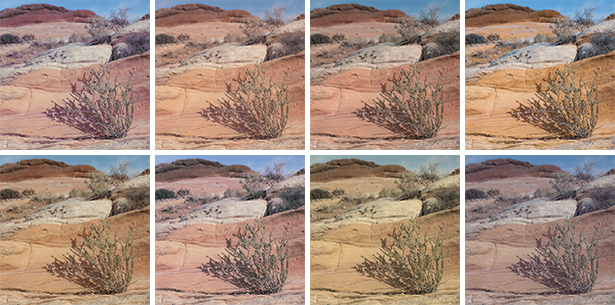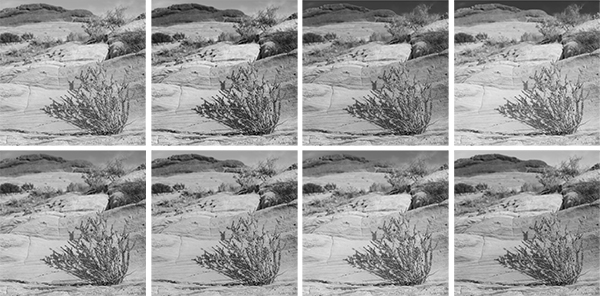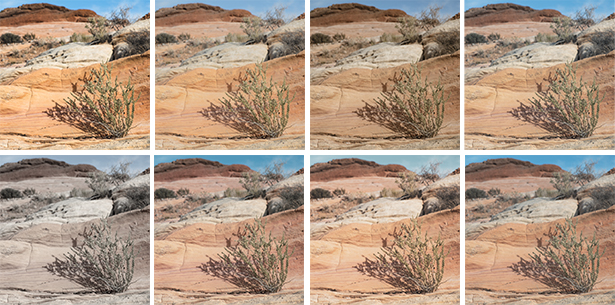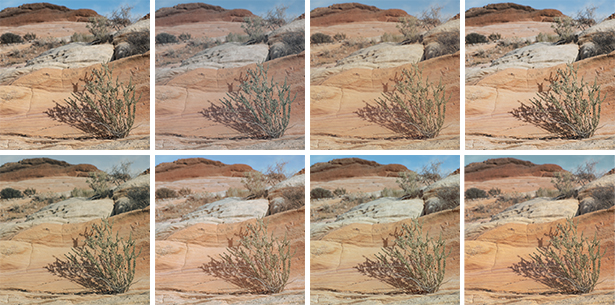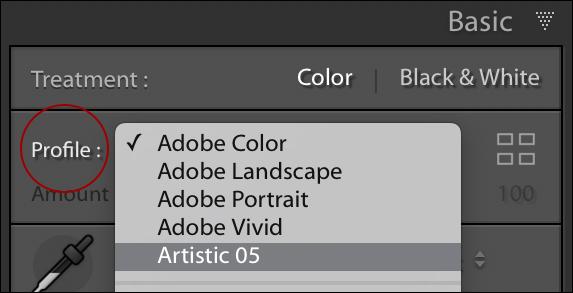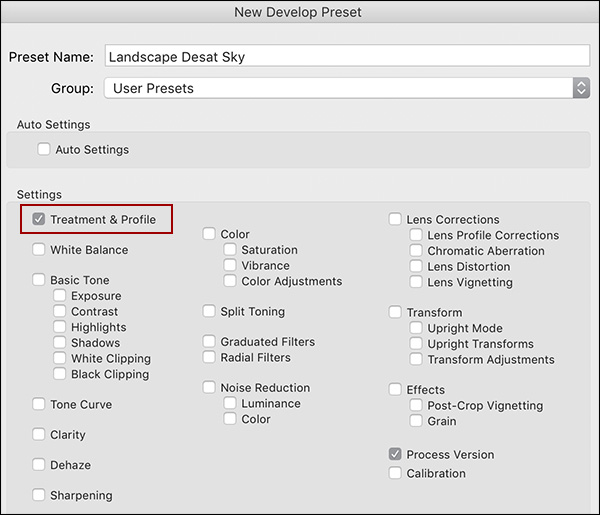In the video below, you’ll discover how to work with profiles in Lightroom Classic to help establish a neutral starting point or apply creative effects to your images.
If you’re not familiar with raw profiles, here is a overview of the key concepts covered in the video above:
PROFILES
A profile is a set of instructions that is used to render a photograph, converting it from raw camera information into the colors and tones that we see.
- Every raw image must have a profile applied.
- Profiles are nondestructive and can be changed at any time without any loss of quality.
The default profile for raw files in Lightroom Classic is Adobe Color for color images and Adobe Monochrome for Black & White images.
- Select Profiles using the Basic panel.
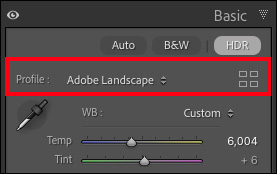
- There are no “right” or wrong” profiles: they’re like filling in a pie – some people will choose cherry and others prefer peach.
ADOBE RAW PROFILES
There are six Adobe Raw profiles which can be applied to raw files.
- Adobe Color — was designed to be a great starting point for any image. The goal of this profile is to render a relatively neutral, baseline image that closely matches the original colors and tones in the original scene. It assumes that you want the ultimate control over refining and adjusting images in order to achieve the exact look that you want. In comparison to the previous default profile, Adobe Color is a bit warmer in the reds, yellow and oranges, has a very small increase in contrast, and, it does a better job of moving highlights between color spaces.
- Adobe Monochrome — was carefully tuned to be the best starting point for any black and white image. This profile slightly shifts colors as they are converted to grayscale – brightening the warmer colors and darkening the cooler colors. It also adds a small amount of contrast but allows lots of headroom for editing.
- Adobe Landscape — adds a bit more saturation to all of the colors in an image and renders more vibrant blues and greens. While this profile adds a slight amount of contrast to the overall image, it also helps to maintain details by slightly compressing the highlight and shadow values in scenes with significant contrast.
- Adobe Neutral — reduces color saturation as well as contrast , rendering a flatter, low contrast version of the image. It‘s designed to give you the most headroom for post processing. This a great profile to start with if you have an image with delicate colors and gradients.
- Adobe Portrait — is tailored especially for portrait images. It has a slightly more gentle tone curve and is optimized for skin tones.
- Adobe Vivid — adds vibrance and contrast while still rendering natural skin tones and is a great place to start for images of people in a landscape.
If the image that you’re working with isn’t set to Adobe Color by default, most likely one of three things is happening:
- You’re working on a non-raw photograph (like a JPEG or TIFF) – in which case the profile will just say Color because all of the rendering was done already (either in another raw processor or within the camera itself) and you can’t apply a raw profile to a non-raw file.
- You’re working on an image captured as DNG via Lightroom on a mobile device and the default profile is Camera Default because images are be optimized differently for images captured on mobile devices.
- You’re working with a legacy file – in which case you will see the previously embedded profile which you can choose to change at any time (Lightroom won’t automatically update legacy files using the new profiles as doing so would change the look of the image.)
ADOBE CAMERA MATCHING RAW PROFILES
In addition, Adobe created and ships Adobe Camera Matching profiles. These profiles are designed to match the preset “styles” that can be set using the menus on a camera. Because the style options differ among camera manufacturers, this list of profiles will change depending on your camera.

The Camera Matching monochrome profiles behave differently from other Black and White profiles (Adobe Monochrome, Legacy, and the Creative Profiles), by discarding the color information in the file. Therefore, the Black and White Mix sliders, are not available. You can however add color tints to these images using the Tone Curve, Split Tone, and color swatch with Local Adjustment tools.
LEGACY RAW PROFILES
Legacy Raw profiles are also included in order to maintain backwards compatibility when working with legacy files.
CREATIVE PROFILES
In addition to Raw profiles, are several groups of Creative profiles. These profiles are designed to apply more creative, stylistic effects to an image and can be applied to non-raw photographs (like JPEG’s and TIFFs). Creative Profiles can (but aren’t required to) use color lookup tables (LUTs) to remap color and tones enabling new and unique ways of processing images. Lightroom ships with several different Creative profiles including:
ARTISTIC PROFILES
These profiles were designed to be more edgy, and typically have stronger color shifts.
B & W Profiles — these profiles were designed to create a more dramatic interpretation of the original image, some of these profiles increase/decrease contrast, others limit the dynamic range, and several emulate the effects of using color filters with film.
Modern Profiles — these profiles were designed to create unique effects that fit in with current photography styles.
Vintage Profiles — these profiles were designed to replicate the effects of analogue imagery.
Using the Amount Slider with Creative Profiles — Most Creative profiles in Lightroom Classic have an Amount slider which can be used to vary the strength of the profile. (I say “most” because the creator of the profile has the option to disable the effect of the Amount slider). Note: the Raw profiles that Adobe ships do not have an Amount slider.
- Using the Amount slider is intuitive: when the Amount slider is moved to the left, it decreases the strength of the Creative profile: moving the slider to the right, amplifies the strength of the profile. But I was curious as to what was happening under the hood – so I went direct to the source and asked my teammate Max. It turns out that when working with raw files, as you decrease the Amount slider, the Creative profile is being blended with a “base” profile within the Creative profile. The Creative profiles that Adobe ships with Lightroom Classical use the Adobe Standard profile as their base profile, but other third parties could designate a different base profile (in which case, their Creative profiles would blend with their custom base profile). This means that if the Amount slider is set to zero, the result would be the same as applying the base profile.
- There are a few exceptions – for example, when working with non-raw images, such as JPEG’s. Because there is no base DNG Camera Profile (DCP) for a JPEG, when you apply a Creative profile and decrease the Amount slider, it will blend with a generic “Color” profile.
- And, there is a small subset of raw and DNG files that don’t use the Adobe Standard profile as the base profile (the profile will be “Embedded”). If this is the case, then the Creative profile will blend with the default, “Embedded” profile.
Previewing and Applying Profiles — You can hover the cursor above a profile to preview the effect in the preview area, however you need to click the profile to apply it (as well as preview an accurate rendition of the image in the Histogram Panel).
- Double click a profile to simultaneously apply it as well as close the Profile Browser.
- Once a profile has been applied, use any of the other slider controls in any of the other panels to make additional modifications to your images. Profiles don’t change slider values.
Quickly Accessing Favorite Profiles — Click the star icon to add a profile to the Favorites group. Click the star again to remove it.
Quickly access Favorites from the Profile drop-down menu (without having to use the Profile Browser).
Including Profiles in a Preset — When saving a preset, you can choose to include Treatment & Profile to save the profile as a part of a preset (just as you would any other attribute or setting in Lightroom).
Managing Profiles — To selectively hide and show groups of profiles, right-click on a Profile set (not an individual profile) and select Manage Profiles.

- Use the check to toggle the visibility of profile sets. Note: the Favorites set can not be hidden.
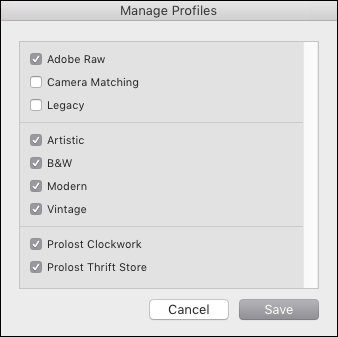
- To reset the visibility of all profiles, Rt-click (Control -click Mac), on a Profile Set and select Reset Hidden Profiles.
- Rt-click (Control -click Mac), on the name of the Profile Set and choose to expand or collapse all Profile Sets.
- When previewing profiles, press and hold Option (Mac) | Alt (Win) to temporarily disable loupe preview for a quick before/after comparison
Importing Profiles — To import profiles, select Import from either the preset panel or profile browser and select the zip file. Lightroom Classic will automatically place the presets and profiles each in the right place:
- From the Presets panel, click the ‘+’ icon and select Import Presets. Select the desired ZIP file and click OK.
- From the Profile Browser, click the ‘+’ icon and select Import Profiles. Select the desired ZIP file and click OK.
Note: both Presets and Profiles will be imported with either of the above methods (XMP presets, XMP profiles, DCP profiles, and LCP profiles). Legacy lrtemplate/image/zip files will not be imported (even if contained inside the ZIP). In addition, Legacy Presets and Profiles are hidden by default.
Same Name Presets — If you attempted to create or import presets with the same name into a group, Lightroom Classic now presents the following three options:
- “Replace” the existing preset (only the latest preset with the same name will exist in the group).
- “Duplicate” the preset (there will be two presets with the same name now listed in the group).
- “Rename the preset” (a default numeric extension is applied to the name or, you can rename it yourself).
Non-Compatible Presets — Presets that are Non-compatible will be grayed-out in the Presets panel. This includes profiles that contain settings that aren’t designed to work with the selected image (for example camera profiles that aren’t applicable to the current photo or presets that only apply to raw files vs. JPEGs). Note: to enable/disable this option, choose Preferences > Presets > Visibility > Show Partially Compatible Develop Presets.
Creating Color Profiles — The video below by Josh Haftel provides an advanced, step-by-step guide to creating Creative Profiles in Adobe Camera Raw for use in Adobe Camera Raw (ACR) 10.3 and later, Lightroom Classic 7.3 and later, and Lightroom CC 1.3 and later. Please keep in mind that profiles are very different from presets, and as such, there’s lots of stuff that can go wrong while making them. Experiment, have fun, and go slowly. For more details and specifics, download the SDK with sample files from this link: http://www.adobe.com/go/profile-sdk
